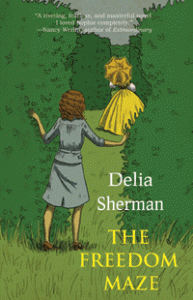One of the major appeals of the KONY 2012 campaign to capture brutal Ugandan warlord Joseph Kony by this December is that, in a contentious election year, it is a nonpartisan effort. The poster to advertise the campaign illustrates that…
Category: Violence/War & Peace/Refugees
Belonging to the Land–a review of Far From Home by Na’ima B Robert
I grew up in the Southwestern Desert of the United States, the Chihuahua Desert, the driest desert of North America. I once wrote an essay about how the land shapes the people there—only survivors are left, I wrote, but we…
Outstanding International Books 2011
Celebrating the best of children’s international books of 2011! Outstanding International Books is a project of the United States chapter of the International Board on Books for the Young. These books reflect excellence in worldwide writing for young readers. The…
Journey of an African Refugee: A Review of Now Is the Time for Running
In the past two years, immigration has become a hot-button issue in the United States, with various states passing harsh immigration laws and vigilante groups patrolling the border. Living in a large country with little coverage of the outside world,…
Longing for Place: Katrina “Refugees” and Beneath a Meth Moon
When we think of refugees, we think of people driven from their homes in developing nations due to war or oppression. Rarely do we think of people fleeing the effects of global climate change as refugees, nor do we consider…
We’ve Got a Job
Several outstanding nonfiction books for youth published in the last few years have told the story of the civil rights movement in Birmingham, Alabama, a city notorious even in the South for its resistance to change and the amount of…
Beyond the Battlefront: The War Between Brothers
Schroder, Monika. My Brother’s Shadow. Farrar, Straus & Giroux: $17.99 ISBN-13: 978-0374351229 War stories often focus on the battlefront or the soldier’s journey. But the realities of war are that they are often fought inside families. Monika Schroder’s My Brother’s…
My Brother’s Shadow
Berlin. 1918. World War I is in its final days. World War II is in the future. Is it possible to see the threads of anti-Semitism and the problems of crushing poverty that led to the rise of the Third…
The Freedom Maze
 The Freedom Maze, by Delia Sherman, will make a good companion for a social studies class, evincing the old adage that “history tells you what happened, historical fiction tells you how it felt.” (If you want a chance at a free copy–two are being offered–contact the publisher, Small Beer Press, for details.)
The Freedom Maze, by Delia Sherman, will make a good companion for a social studies class, evincing the old adage that “history tells you what happened, historical fiction tells you how it felt.” (If you want a chance at a free copy–two are being offered–contact the publisher, Small Beer Press, for details.)
Presuming that the issue of slavery is addressed in any depth in American classrooms, it will be useful for middle schoolers to see the system in action. It was certainly educational for me. Slavery–historical and contemporary–is an easy subject to not want to think about, so I knew very little about what slave culture was like on a plantation, just assumed the general horror. It was terrible, but the era covered in this novel was also rich in language, food, spirituality, and nurturance.
Set in 1960, not exactly an era we associate with complete emancipation for African Americans, Sophie, who is white, is not only dealing with the emotional gyrations of adolescence, but in a time where divorce wasn’t as common place, she suffers the stigma of having a single mother and an absentee father. Her mother, embittered by the experience and needing to work as a secretary, leaves Sophie with her aunt and grandmother on what’s left of the family’s plantation. Bored and lonely, she spends most of the day outdoors, getting darker in the sun and playing in the natural world around her. She discovers a run-down maze on the property where decay disguises a magical element: An otherworldly being that she calls the Creature transports her back in time one hundred years where Sophie has to face the grisly realities of her slave-owning ancestry. Mistaken for the biracial bastard child of one of the wayfaring plantation owners, she is thrust onto the opposite side of the slave/owner dichotomy that had benefited her ancestors. Unable to convince the Creature to return her to the present, she learns she has a purpose in traveling back, which is to save a slave girl from a violation for which there was no vocabulary in 1860, and help her escape to New York. (I was reading the escape scenes on the elliptical trainer at the gym and was so engrossed by the complications that I didn’t notice an irritated patron waiting for me to get off when my time was up.)
Though the reading age target is listed as ten and up, teachers will need to be clever in getting around some of the thorny issues. What has come to be called the N-word is used in context, though not liberally, and there is the issue of the potential rape of a young girl, which illustrates the utter powerlessness of the enslaved population.
While heartache thrums throughout the book–children have been sold away from their parents, bodies are worked like machines and beaten liberally, living conditions are despicable–there is the clear bell of hope, that sound in children’s literature that is too tough to destroy.
The War Comes Home II: A Review of The Knife and the Butterfly
Last October I spoke on a panel with four other authors, including fellow Pirate Tree-huggers J.L. Powers and Nancy Bo Flood, on the topic of children’s literature and war. My part on children as combatants included G. Neri and Randy…